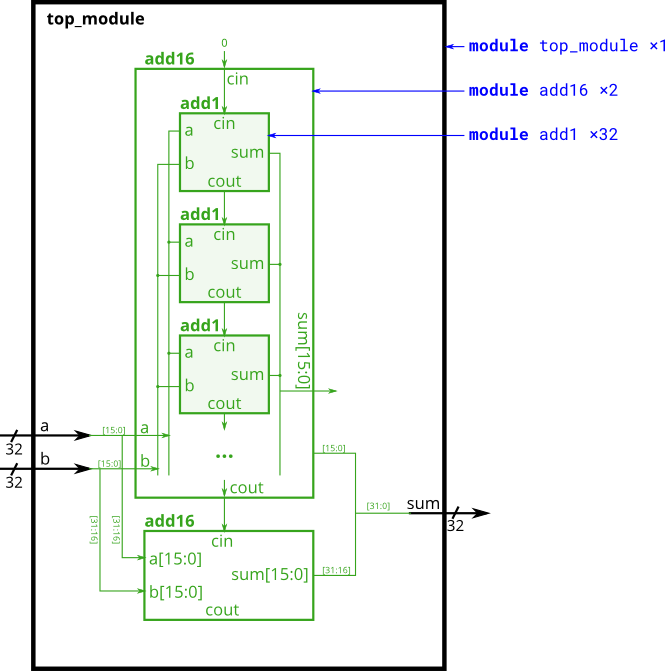Module fadd
Problem Statement
In this exercise, you will create a circuit with two levels of hierarchy. Your top_module will instantiate two copies of add16 (provided), each of which will instantiate 16 copies of add1 (which you must write). Thus, you must write two modules: top_module and add1.
Like module_add, you are given a module add16 that performs a 16-bit addition. You must instantiate two of them to create a 32-bit adder. One add16 module computes the lower 16 bits of the addition result, while the second add16 module computes the upper 16 bits of the result. Your 32-bit adder does not need to handle carry-in (assume 0) or carry-out (ignored).
Connect the add16 modules together as shown in the diagram below. The provided module add16 has the following declaration:
Within each add16, 16 full adders (module add1, not provided) are instantiated to actually perform the addition. You must write the full adder module that has the following declaration:
Recall that a full adder computes the sum and carry-out of a+b+cin.
In summary, there are three modules in this design:
top_module— Your top-level module that contains two of...add16, provided — A 16-bit adder module that is composed of 16 of...add1— A 1-bit full adder module.
If your submission is missing a module add1, you will get an error message that says Error (12006): Node instance "user_fadd[0].a1" instantiates undefined entity "add1".
Tip
Full adder equations:
sum = a ^ b ^ cin
cout = a&b | a&cin | b&cin
My Solution
module top_module (
input [31:0] a,
input [31:0] b,
output [31:0] sum
);//
reg [15:0] sum1;
reg [15:0] sum2;
wire cout;
add16 u_add16_1(
.a(a[15:0]),
.b(b[15:0]),
.cin(0),
.cout(cout),
.sum(sum1)
);
add16 u_add16_2(
.a(a[31:16]),
.b(b[31:16]),
.cin(cout),
.cout(),
.sum(sum2)
);
assign sum = {sum2, sum1};
endmodule
module add1 ( input a, input b, input cin, output sum, output cout );
// Full adder module here
assign sum = a ^ b ^ cin;
assign cout = a & b | a & cin | b & cin;
endmodule
Note
- 最开始实现的是:一个16位加法器和16个1位加法器,提交以后总是报错。
- 于是在网上搜索答案,看到这篇文章:HDLBits 题目打卡module fadd、module cseladd-CSDN博客,才发现是实现例化两个16位的加法器和实现一个1位加法器。看来连题目都没有理解清除。
